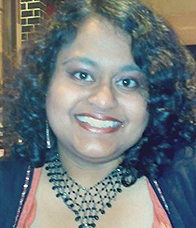Rao discusses India’s caste system and its influence on media

An imbalance in media ownership among India’s castes leads to a narrow definition of Indian culture, reinforcement of negative stereotypes and perceptions of superiority and inferiority among different members of society, according to doctoral student Pallavi Rao.
She presented this in her most recent paper, “The Brahmin as ‘Culture’ and the Dalit as ‘Death’,” Friday as a part of The Media School’s weekly research colloquium. Rao, an Indian native herself, hopes to turn the paper into a dissertation chapter and eventually have it as a scope for some ethnographic fieldwork or an interview project.
In keeping with Hindu religious practices, India is divided into castes and sub-castes that determine one’s social status and wealth. The country’s class structure is complex, but, for the sake of simplicity, Rao broke the system down into five castes: the Brahmins, Kshatriyas, Vaishyas, Sudras and Dalits. Her research mainly focused on the Brahmins, who aren’t necessarily materially wealthy but have a high social status, and the Dalits, otherwise known as “untouchables.” Caste is determined paternally and can have a major influence on how one is treated in society.
According to India’s most recent census, Brahmins, Kshatriyas and Vaishyas, considered the “upper castes,” make up less than 20 percent of the population combined but control 71 percent of the media. Dalits alone represent around 16 percent of the population, yet they control no media.
“This puts into context the questions of representation and explains some of the problems we see,” Rao said.
These problems involve Dalits being exclusively covered in the context of rape, murder and violence and Brahmins being shown as the definitive source of modern Indian culture, Rao said. This trend can be seen across Indian literature, religious texts and film, but Rao mainly analyzed it within English-language print news.
The rape and murder of Dalit bodies is used to reveal the shortcomings of the government and the breakdown of social order. Death allows the Dalit to become visible. —Doctoral student Pallavi Rao
As an example, Rao discussed a news story from 2016 that covered the suicide of a Dalit doctoral student. After getting into an altercation with his university’s administration, the student was expelled and lost all his funding, leaving him homeless and penniless for six months. Suicide is not uncommon among Dalits, but because he left a suicide note, this particular Dalit’s suicide received a lot of media attention.
Rao discussed several other articles covering rape, murder and violence in and against the Dalit community, showing that these articles’ narrow themes and propensity for playing up the victims’ Dalit caste status led to stereotypes and the reaffirmation of caste hierarchy.
“The rape and murder of Dalit bodies is used to reveal the shortcomings of the government and the breakdown of social order,” Rao said. “Death allows the Dalit to become visible.”
But, who is the Dalit usually invisible to? The Brahmin. Rao argued that because most of the journalists and editors creating this content are Brahmins themselves, many distinctively Brahmin cultures and traditions are portrayed as representative of India as a whole. For example, most of the food and recipes in Indian media are vegetarian dishes because Brahmins are staunch vegetarians. And most of the art coverage in the news is dedicated to Brahmin artists and traditions.
“We are left implicitly making assumptions that these are cultures that need to be preserved and are very valuable in some way,” Rao said. “It is showing Brahmin culture as if it is representative of the entire Indian culture.”
This, Rao said, can lead to “Brahmin supremacy” and even “caste-ism,” in which Brahmins focus on their lineage going back to mythical Hindu figures and Europeans. So when Brahmins see themselves as representative of Indian culture and the only group who is succeeding, “the implication is that it is genetic,” Rao said. “They believe there is something in them that pushes them to be better than everybody else.”
But according to Rao, the media isn’t the only stakeholder at fault for maintaining this class divide. She also says academia has not given the intricacies of this social structure enough attention, and since academia is where many journalists originate, this negligence influences the media.
Rao says there is no clear-cut answer. Simply diversifying the journalist pool won’t necessarily influence the binary caste system that is so deeply engrained in the media.
More:

